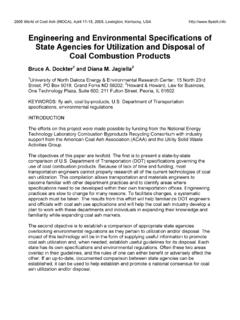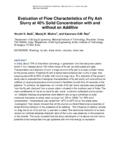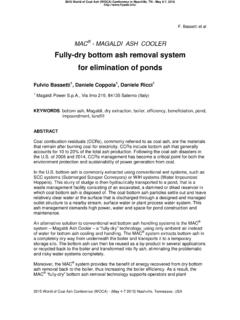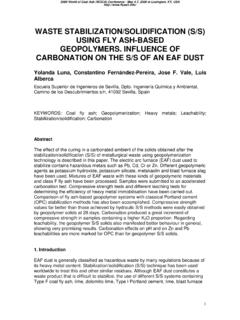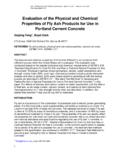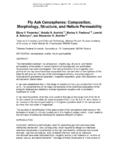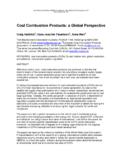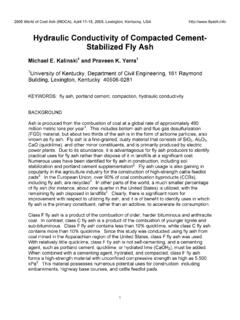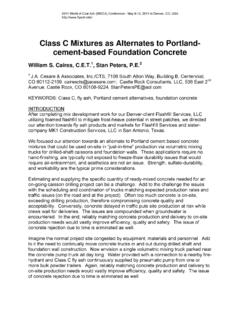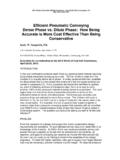Transcription of High Performance Bricks from Fly Ash
1 high Performance Bricks from fly ash Obada Kayali1 1 School of Aerospace, Civil and Mechanical Engineering, University of New South Wales at The Australian Defence Force Academy, Canberra, ACT 2600. KEYWORDS: fly ash , Bricks , compressive strength, lightweight, absorption, high Performance , tensile strength, durability. ABSTRACT Bricks whose solid ingredient is 100% fly ash have been manufactured. The manufacturing process uses techniques and equipment similar to those used in clay brick factories. The Bricks produced were about 28% lighter than clay Bricks . The Bricks manufactured from fly ash possessed compressive strength higher than 40 MPa. This exceeds some of the best of load carrying clay Bricks available by more than 25% and is several times better than acceptable commercially available common clay Bricks .
2 Other important characteristics of the fly ash Bricks have been evaluated. These included absorption capacity, initial rate of absorption, modulus of rupture, bond strength and durability. The values of these characteristics for fly ash Bricks are excellent and have exceeded those pertaining to clay Bricks . Moreover, fly ash Bricks have been produced with a naturally occurring reddish colour similar to that of normal clay Bricks . The new Bricks and process have been patented and the new Bricks have been given the name FlashBricks. This paper presents the results of testing and the advantages gained by this type of Bricks over conventional clay Bricks . INTRODUCTION The ever increasing volume of fly ash quantities in the world has not been remotely matched by its utilisation.
3 Australia is an example where such utilisation has been minimal. The most important and popular use of fly ash in Australia has been the partial replacement of portland cement. Australia shares most of the Western countries in similar methods and traditions as far as residential buildings are concerned. These include Bricks as the main constituent. It is therefore natural that the brick industry presents an opportunity for the efficient utilisation of the vast quantities of fly ash . Conservative attitudes are among the factors that limited the use of fly ash in concrete to generally a maximum of 25% replacement of Portland cement. This conservatism can be understood in the context of concrete where the ash is mixed raw, and the effects 12005 World of Coal Ash (WOCA), April 11-15, 2005, Lexington, Kentucky, high volume replacement are still subject to research and sometimes controversy.
4 It is however not quite justifiable that the brick industry should take similar conservative attitude. Environmental concerns have been raised in some parts of the world where coal is the main power generating resource and where Bricks are also the main building material. Such concerns have resulted in legislation that obliges the brick industry to incorporate at least 25% by weight of fly ash and /or bottom or pond ash in the brick making mixture if the industry is within 50 km from a coal power generation ,2 Some successful ventures have been reported where fly ash was incorporated in the mixture at the rate of 20 to 50%.3 Nevertheless, there is only little evidence that incorporation of fly ash in the brick mixture has exceeded the 30% by volume even when the legislation was Reasons behind such reluctance are not clear.
5 A most probable reason is the fear of change in many small factories and the ingrained conservatism in the attitude of stake holders of the large producers. Added to this is the fact that with an existing clay brick factory, the incorporation of fly ash is a potential addition of cost. The possible incompatibility of the ash with the clay and shale during the various processes of production including the crucial one of firing may be a legitimate difficulty. At high temperatures beyond 1000o C, the temperature and length of time of firing become very sensitive to the type of ash and of course to the clay and shale if in the same mixture. This would be the case as long as the factory still uses the ash as partial replacement to the main clay and shale ingredients.
6 The situation may become completely different when the ash is the only ingredient of the Bricks mixture. Compatibility is no more an issue in such a case. So far, few attempts at manufacturing Bricks from more than 80% ash have been ,6 The author believes that fly ash on its own can be an excellent raw material for brick making. This has now been proven and a patent is taken for the manufacture of Bricks from fly The response of the ash to firing temperature at 1000o C and beyond can be accurately controlled even in small factories. The potential savings with this approach are many. These are illustrated in the following sections. Savings in production and transportation costs and producing Bricks of superior qualities to those of standard clay Bricks are in addition to the environmental solution that such venture may bring about.
7 brick PRODUCTION The Bricks , produced according to the patent 7, have been given the name FlashBricks. Essentially, the only solid ingredient of the Bricks is the ash. The main liquid ingredient is water. Other ingredients that so far are commercially protected are cheap, commonly available and, though essential, are only minor in quantities. The technology, subject of the patent, includes the method of mixing, forming into moulds, curing and firing. These are easily adaptable by existing clay brick factories. The technology uses less energy than that needed in the manufacture of clay Bricks . Furthermore, it requires less manpower and less area is needed for material processing than in the case of clay brick production.
8 2 Table 1. Items of difference in the production process and expected to make cost difference: Common Load Bearing Clay Bricks Load Bearing FlashBricks Factory location On site of raw materials Any where, preferably on site of coal power station Factory location Must change when material depletes No change needed Excavation needed required None Raw materials qualities Varies daily consistent Raw material needed per 1000 Bricks 4-5 tonnes of clay and shale tonnes of fly ash Raw materials wastage per 1000 Bricks tonnes of clay and shale None Grinding of rocks required None to grind Mixing dry materials required None Additive (subject to provisional confidentiality)
9 None Required @ kg Drying green units 7 days 3 days Temperature of firing the units 1000oC- 1300oC (1832 F-2372 F) 1000oC- 1300oC (1832 F-2372 F) Length of firing time 1day-7 days Few hours (subject to provisional confidentiality) Table 1 summarises the differences in the manufacturing process between the clay Bricks and the FlashBricks. A very important saving that can be readily seen is that of personnel. Since neither excavation nor grinding is needed, the personnel that are usually employed for such operations will not be required. Added to this is the need for continual assessment of the raw materials in the case of clay Bricks . Such assessment is not needed in the case of FlashBricks because the ash is analysed continually at the power generation station as a mandatory practice.
10 Thus the personnel involved in the assessment of clay materials will not be required with FlashBricks production. Further market study of the items outlined above is required so that figures may be assigned to total savings with FlashBricks. 3So far the production of FlashBricks has been performed in the laboratory. This has been repeated successfully many times and the testing has produced consistent results. Figure 1 shows the moulded Bricks in their fresh state. Figure 1. Freshly moulded FlashBricks Figure 2 shows a brick that had been cured for two days before firing. The Bricks solidify enough to be fired after 24 hours but are best fired after three days of curing. The brick shown in the photograph of Figure 2 is split open to reveal the interior structure.
